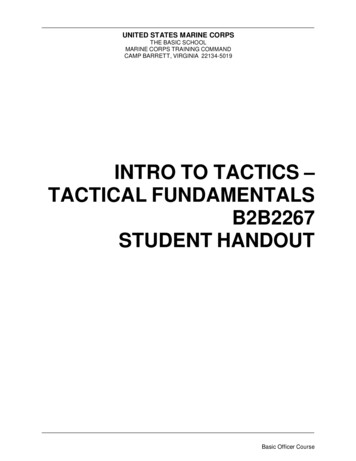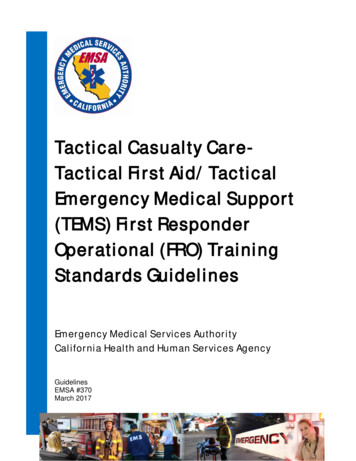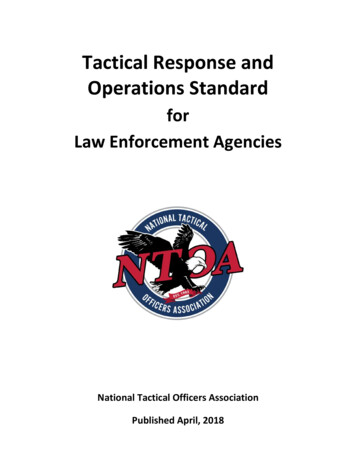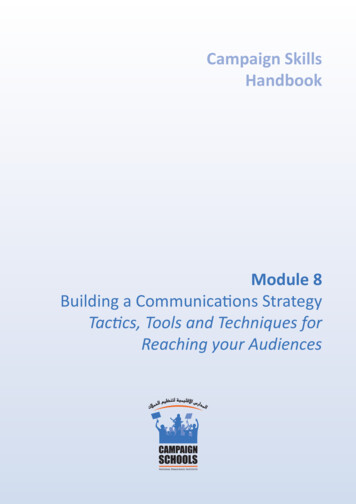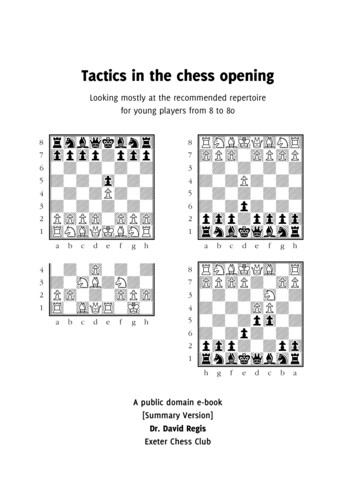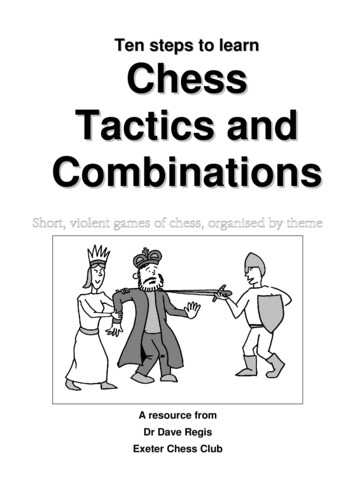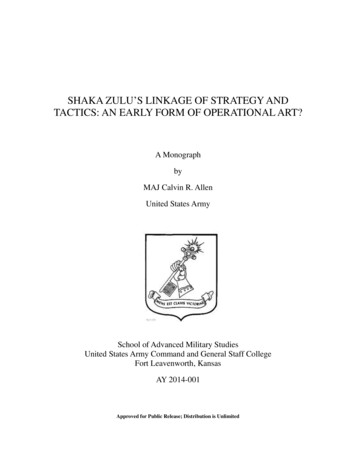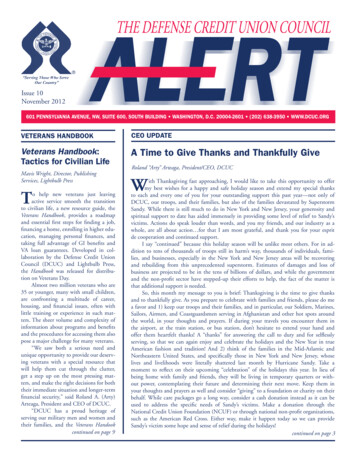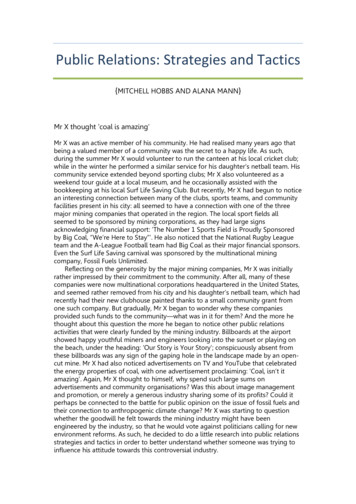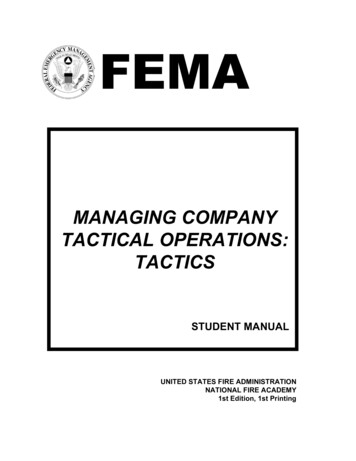
Transcription
FEMAMANAGING COMPANYTACTICAL OPERATIONS:TACTICSSTUDENT MANUALUNITED STATES FIRE ADMINISTRATIONNATIONAL FIRE ACADEMY1st Edition, 1st Printing
FEMA/USFA/NFAMCTO-T-SM1st Edition, 1st PrintingManaging Company TacticalOperations: Tactics
FEMAMANAGING COMPANYTACTICAL OPERATIONS:TACTICSSTUDENT MANUALUNITED STATES FIRE ADMINISTRATIONNATIONAL FIRE ACADEMYJanuary 1999
MANAGING COMPANY TACTICAL OPERATIONS: TACTICSNOTICE:This material has been developed by the National Fire Academy (NFA) of the UnitedStates Fire Administration (USFA) for use by state and metropolitan fire trainingprograms. NFA endorsement of this material is conditional on use withoutmodification. NFA material, whether printed text or software, may not be used in anymanner that would mislead or that would suggest or imply endorsement by NFA of anycommercial product, process, or service.ii
MANAGING COMPANY TACTICAL OPERATIONS: TACTICSFEDERAL EMERGENCY MANAGEMENT AGENCYUNITED STATES FIRE ADMINISTRATIONNATIONAL FIRE ACADEMYFOREWORDThe Federal Emergency Management Agency (FEMA) was established in 1979. FEMA's mission is tofocus federal effort on preparedness for, mitigation of, response to, and recovery from emergenciesencompassing the full range of natural and manmade disasters.FEMA's National Emergency Training Center (NETC) in Emmitsburg, Maryland, includes the UnitedStates Fire Administration (USFA), its National Fire Academy (NFA), and the Emergency ManagementInstitute (EMI).To achieve the Academy's legislated mandate (under Public Law 93-498, October 29, 1974), "to advancethe professional development of fire service personnel and of other persons engaged in fire prevention andcontrol activities," the National Fire Academy has developed an effective program linkage with establishedfire training systems which exist at the state and local levels. It is the responsibility of this division tosupport and strengthen these delivery systems. Academy field courses have been sponsored by therespective state fire training systems in every state.The Managing Company Tactical Operations (MCTO) curriculum is designed to meet the needs ofCompany Officers responsible for managing the operations of one or more companies in structuralfirefighting operations. The curriculum consists of three separate, but interdependent courses: MCTO:Preparation; MCTO: Decisionmaking; and MCTO: Tactics. The three courses provide a systematicapproach to fire incident management; as such, they are designed to be taken sequentially.Recently, the curriculum for this course has been revised. The revisions were made to apply recent work innaturalistic decisionmaking, and particularly a Recognition-Primed Decision (RPD) model of howfireground commanders actually make decisions when faced with time pressure and uncertainty.Calderwood (Fire Command, August, 1988) has described the research project that showed that firegroundcommanders rarely generate alternative options and evaluate these options systematically to select the best.There simply is not sufficient time. Moreover, the fireground commanders are able to use their experienceto identify a reasonable course of action as the first one they consider. Generally, commanders takeadvantage of their experience to initiate a course of action rapidly, which is how they can make decisionsso quickly. If the commanders are concerned about whether the typical course of action will be successfulin the actual situation they are facing, the common strategy is to imagine how the course of action will becarried out, looking for ways in which it might lead to complications. If none are found, the course ofaction is initiated. If minor complications are found, the fireground commander will try to improve theaction. If the improvements aren't going to work, the commander will reject the action and consideranother typical strategy.Although the RPD model appears to describe how fireground commanders make decisions, we have notincluded the model in the student materials. Little is to be gained by explaining to you how you alreadythink. Instead, the revisions have been based on the RPD model. Since situation awareness, or sizeup, isso central to effective decisionmaking, we have enhanced the materials describing the critical cues formaking difficult judgments. Critical cues are those that can cause a shift or an elaboration in thecommander's assessment of the situation. This should help you gain a better sense of what you aremonitoring. A second modification is to provide guidance to instructors about how best to use debriefingsthat follow exercises.iii
MANAGING COMPANY TACTICAL OPERATIONS: TACTICSAs you proceed through the course, you may have questions that can't be answered in these materials. TheUnited States Fire Administration (USFA) has many publications that may be helpful. A list of these canbe obtained by calling 1-800-238-3358, extension 1358.To request one of these publications by title or by publication number, call the automated service number:1-800-238-3358, extension 1660.The USFA's Learning Resource Center also is available to assist with further research; call 1-800-2383358, extension 1030.The staff of the National Fire Academy is proud to join with state and local fire agencies in providingeducational opportunities to the members of the nation's fire services.iv
MANAGING COMPANY TACTICAL OPERATIONS: TACTICSTABLE OF CONTENTSPAGEForeword .Table of Contents .Course Schedule .iiivviiMODULE 1:INTRODUCTION .SM 1-1MODULE 2:VENTILATION AND RESCUE .SM 2-1MODULE 3:FIRE CONFINEMENT AND EXTINGUISHMENT .SM 3-1MODULE 4:WATER SUPPLY AND EXPOSURE PROTECTION.SM 4-1MODULE 5:SALVAGE, OVERHAUL, AND SUPPORT ACTIVITIES .SM 5-1MODULE 6:PRIVATE DWELLING SIMULATIONS .SM 6-1v
MANAGING COMPANY TACTICAL OPERATIONS: TACTICSvi
MANAGING COMPANY TACTICAL OPERATIONS: TACTICSCOURSE SCHEDULEMODULEModule 1:IntroductionModule 2:Ventilation and RescueModule 3:Fire Confinement and ExtinguishmentModule 4:Water Supply and Exposure ProtectionModule 5:Salvage, Overhaul, and Support ActivitiesModule 6:Private Dwelling Simulationsvii
MANAGING COMPANY TACTICAL OPERATIONS: TACTICSMODULE 1:INTRODUCTIONOBJECTIVESThe students will:1.Explain the purpose and use of the Communications Model and the Quick Access Prefire Plan intactical operations at fire incidents.2.Define the relationship between incident priorities, strategy, tactics, and implementation in thecommand sequence.3.Select the appropriate strategic mode, based upon consideration of risk/benefit and availableresources.4.Describe the six steps required to implement the Tactical Action Model.5.List the factors on which apparatus placement is based.
INTRODUCTIONSM 1-2
INTRODUCTIONNOTE-TAKING GUIDEI.II.INTRODUCTIONA.Administrative details.B.The Managing Company Tactical Operations (MCTO) curriculum.1.MCTO: Preparation.2.MCTO: Decisionmaking.3.MCTO: Tactics.HISTORY OF THE INCIDENT COMMAND SYSTEMIn the early 1970's, Southern California experienced several devastating wildlandfires. The overall cost and loss associated with these fires totaled 18 million perday. This multijurisdictional disaster was the impetus for the development of animproved interagency incident management system known as the IncidentCommand System (ICS). ICS is one of the beneficial results of a federally fundedproject called FIRESCOPE that was convened after these fires, and whose charterwas to examine various aspects of interagency response to incidents.SM 1-3
INTRODUCTIONFIRESCOPE derives its name from: FIre RESources of California Organized forPotential Emergencies. The FIRESCOPE ICS is primarily a command andcontrol system delineating job responsibilities and organizational structure for thepurpose of managing day-to-day fire and rescue operations. It also is flexibleenough to manage catastrophic incidents involving thousands of emergencyresponse and management personnel.The National Inter-Agency Incident Management System (NIIMS) is anothersystem using ICS that was developed by the wildland community in order toprovide a common system for wildland fire protection agencies at the local, State,and Federal levels. The NIIMS organization includes the Bureau of LandManagement, the Bureau of Indian Affairs, the U.S. Fish and Wildlife Service,the U.S. Forest Service, representatives of State Foresters, and the National ParkService. NIIMS consists of five major subsystems that collectively provide a totalsystems approach to risk management: The ICS which includes operating requirements, eight interactivecomponents, and procedures for organizing and operating an onscenemanagement structure. Training that is standardized and supports the effective operations ofNIIMS. A qualification and certification system that provides personnel across theNation with standard training, experience, and physical requirements tofill specific positions in the ICS. Publications management that includes development, publication, anddistribution of NIIMS materials. Supporting technologies such as orthophoto mapping, infraredphotography, and a multiagency coordination system that supports NIIMSoperations.Since the development of the ICS, the fire service has experienced severalchallenges in understanding its application. As a result, inconsistencies in thesystem began to develop; other hybrid systems came into existence, furtherdistancing a common approach to incident command. A single incidentmanagement system is critical for effective command and control of majorincidents. At these incidents, a single department may interface with otheragencies on the local, State, and Federal level. In order to reduce the inherentconfusion that may be associated with larger scale incidents, using a commoncommand system is a must.SM 1-4
INTRODUCTIONRecognizing the challenges that were occurring in the fire service in applying acommon approach to incident command, the National Fire Service IncidentManagement System Consortium was created. Developed in 1990, its purpose isto evaluate an approach to developing a single Command system. TheConsortium consists of many individual fire service leaders, representatives ofmost major fire service organizations, and representatives of Federal agenciesincluding FIRESCOPE. One of the significant outcomes of the work done by theConsortium was the identification of the need to develop operational protocolswithin ICS, so that fire and rescue personnel would be able to apply the ICS asone common system. In 1993, as a result of this, the IMS Consortium completedits first document: Model Procedures Guide for Structural Firefighting.FIRESCOPE adopted this in principle as an application to the ModelFIRESCOPE ICS. The basic premise is that the organizational structure found inthe FIRESCOPE ICS now is enhanced with operational protocols that allow theNation's fire and rescue personnel to apply the ICS effectively regardless of whatarea in the country they are assigned. The National Fire Academy, (NFA), havingadopted the FIRESCOPE ICS in 1980, has incorporated this material in itstraining curriculum and will continue to reach the thousands of fire servicepersonnel with one common incident command and control system.It is important to note that the FIRESCOPE Model ICS has had other applicationsor modules similar to the structural firefighting applications that have been inplace for some time. These create a framework for other activities to operate inand further enhance the use of ICS. As an example, there are the Multi-Casualty,Hazardous Material, and the Urban Search and Rescue applications.The Federal Emergency Management Agency (FEMA) formally adoptedFIRESCOPE ICS as the incident management system for any Federal responserequired by the agency. Since then, several other Federal agencies have adoptedFIRESCOPE ICS.III.THE MCTO: TACTICS COURSEA.Course goal.MCTO: Tactics is designed to develop the management skills needed byCompany Officers (COs) to accomplish assigned tactics at structure fires.SM 1-5
INTRODUCTIONNOTE-TAKING GUIDEIV.SM 1-6B.Target audience: Company Officers.C.Activities and scenarios: based on structure fires in buildings of threestories or less.D.Student Manual.COMMUNICATIONA.Effective communication is critical to successful incident management.B.It contributes to improved firefighter safety, accountability of personnel,effective use of resources, incident scene coordination, and interagencycooperation.C.The Communications Model. (See SM 1-16)
INTRODUCTIONNOTE-TAKING GUIDED.V.Example of the Communications Model. (See SM 1-17)REVIEW OF QUICK ACCESS PREFIRE PLAN (QAP)SM 1-7
INTRODUCTIONNOTE-TAKING GUIDESAMPLE PLOT PLAN/FLOOR PLANPLOT PLANSM 1-8
INTRODUCTIONNOTE-TAKING GUIDESample Quick Access Prefire PlanBuilding Address: 1233 Main StreetBuilding Description: 2-story "ordinary" construction with basementRoof Construction: Beam and rafter, 1" x 8" sheathing, composition coveringFloor Construction: 2" x 10" joists; 1" x 6" sheathingOccupancy Type:Initial Resources Required:Mercantile "men's clothing"1 Rescue, 2 Engines, 1 LadderHazards to Personnel:Large amount of rental clothing stored in basementLocation of Water Supply:Available Flow:Main Street & 29th Avenue1,500 gpmEstimated Fire FlowLevel of Involvement25%50%75%100%Estimated Fire Flow8001,6002,4003,200Fire Behavior Prediction:Rapid horizontal and vertical spreadPredicted Strategies:Rescue, confinement, ventilation, extinguishmentProblems Anticipated:Only one access/egress to basement and second floorStandpipe:NoSprinklers:NoFire Detection:NoSM 1-9
INTRODUCTIONNOTE-TAKING GUIDEVI.REVIEW OF THE COMMAND SEQUENCEA.Incident priorities: life safety, incident stabilization, and propertyconservation.B.The command sequence--a three-phase decisionmaking process used todetermine how incident priorities are achieved.C.1.Performing sizeup: the thinking phase.2.Determining strategy and selecting tactics: the planning phase.3.Implementing the action plan: the acting phase.Example of using the command sequence.1.SM 1-10Conditions.
INTRODUCTIONNOTE-TAKING GUIDEVII.2.Problem identification.3.Action plan.4.Tasks.RISK/BENEFIT EVALUATIONA.Firefighting is not without risk; the Incident Commander (IC) mustdetermine if risks taken are worth the benefits gained.B.Company Officers (COs) must also make risk/benefit judgments.C.COs must always be sensitive to changes in conditions that might affecttheir company or others; when such conditions exist, COs mustcommunicate the facts to those potentially affected.SM 1-11
INTRODUCTIONNOTE-TAKING GUIDEVIII.STRATEGIC MODEA.Choice of mode is based on risk/benefit evaluation and/or assessment ofrequired and available resources.B.Strategic modes: offensive, defensive, and transitional.C.Offensive: coordinated interior attack.D.Defensive: attempt to keep fire to area of present involvement withminimum risk to personnel.E.Transitional: switching from one mode to the other.SM 1-121.Defensive to offensive.2.Offensive to defensive.
INTRODUCTIONNOTE-TAKING GUIDEIX.TACTICAL ACTION MODELA.A six-step process whereby the CO receives and implements a tactical ortask order.B.Step 1: Receive a tactical or task order.C.Step 2: Conduct a tactical sizeup.D.Step 3: Assign tasks.E.Step 4: Take action to complete tactical assignment.F.Step 5: Evaluate effectiveness of tactical operations.G.Step 6: Report to supervisor on the effectiveness of tactical operations.SM 1-13
INTRODUCTIONNOTE-TAKING GUIDEX.APPARATUS PLACEMENTA.B.SM 1-14Placement is based on five factors.1.Strategic mode.2.SOPs for first-arriving companies.3.Prearranged staging procedures.4.Direct order from IC.5.Decision made by CO upon arrival.Placement considerations.
INTRODUCTIONNOTE-TAKING GUIDEC.Tactical assignment examples that dictate placement.1.Engine being used for water supply.2.Engine being used to supply sprinkler or standpipe.3.Engine being used for initial fire attack.4.Engine being used for defensive operation/master stream.5.Truck being used on a rescue assignment.6.Truck being assigned roof ventilation.7.Truck being assigned to provide ground ladders and equipment.SM 1-15
INTRODUCTIONNOTE-TAKING GUIDEXI.8.Truck being used for defensive operation/master stream.9.Rescue unit being used for equipment usage.10.Tanker/tender being used for water shuttle.SUMMARYSM 1-16
INTRODUCTIONINTRODUCTIONThe Managing Company Tactical Operations (MCTO) curriculum isdesigned for newly appointed Company Officers (COs) and forfirefighters who may have acting CO responsibilities. It also serves as anexcellent review for experienced officers. The curriculum presentlyincludes three components: Preparation, Decisionmaking, and Tactics.This module includes a review of material from MCTO: Preparation andMCTO: Decisionmaking that is critical to understanding this course. Italso provides an overview of this course and some brief backgroundinformation on the Tactical Action Model, strategic mode, and apparatusplacement.Managing Company Tactical Operations: Preparation provides afoundation for managing one or more companies operating at structuralfire incidents. Key content areas include: Roles and Responsibilities;Readiness; Communication; Building Construction and Fire BehaviorFactors; and Preincident Preparation.Managing Company Tactical Operations: Decisionmaking providesan effective approach to command decisionmaking and organization. Keycontent includes: The Command Sequence; Sizeup; Developing an ActionPlan; Implementing the Action Plan; and Introduction to the IncidentCommand System. The extensive use of simulation provides theopportunity to apply concepts and develop tactical skills.Managing Company Tactical Operations: Tactics develops themanagement skills needed by Company Officers to accomplish assignedtactics at structure fires. Key content areas include: An Introduction;Ventilation and Rescue; Fire Confinement and Extinguishment; WaterSupply and Exposure Protection; Salvage, Overhaul, and SupportActivities; and Private Dwelling Simulations. The extensive use ofsimulation provides the opportunity to apply concepts and develop tacticalskills.COMMUNICATIONEffective communication is critical to successful incident management. Itcontributes to improved firefighter safety, accountability of personnel,effective use of resources, incident scene coordination, and interagencycooperation.SM 1-17
INTRODUCTIONThe Communications ModelThe meaning of words is based on prior knowledge and experiences of theindividual. Communication fails when individuals associate differentmeanings with the same word. The purpose of communication is toestablish mutual understanding. Following the Communications Modeldevelops confidence in your ability to communicate effectively, and itmakes good communication a matter of habit.The Model is a six-step process.Step one: The sender formulates an idea that he/she wants to conveyto another person.The idea must be clear and concise. If the idea is not clear to thesender it will be less so to another person. Too much informationin the message increases the chance that some of it will be lost.Step two: The sender sends the message.First, the sender must get the attention of the intended receiver andthen convey the information.Step three: The message is transferred through
States Fire Administration (USFA), its National Fire Academy (NFA), and the Emergency Management Institute (EMI). To achieve the Academy's legislated mandate (under Public Law 93-498, October 29, 1974), "to advance the professional development of fire service pers
